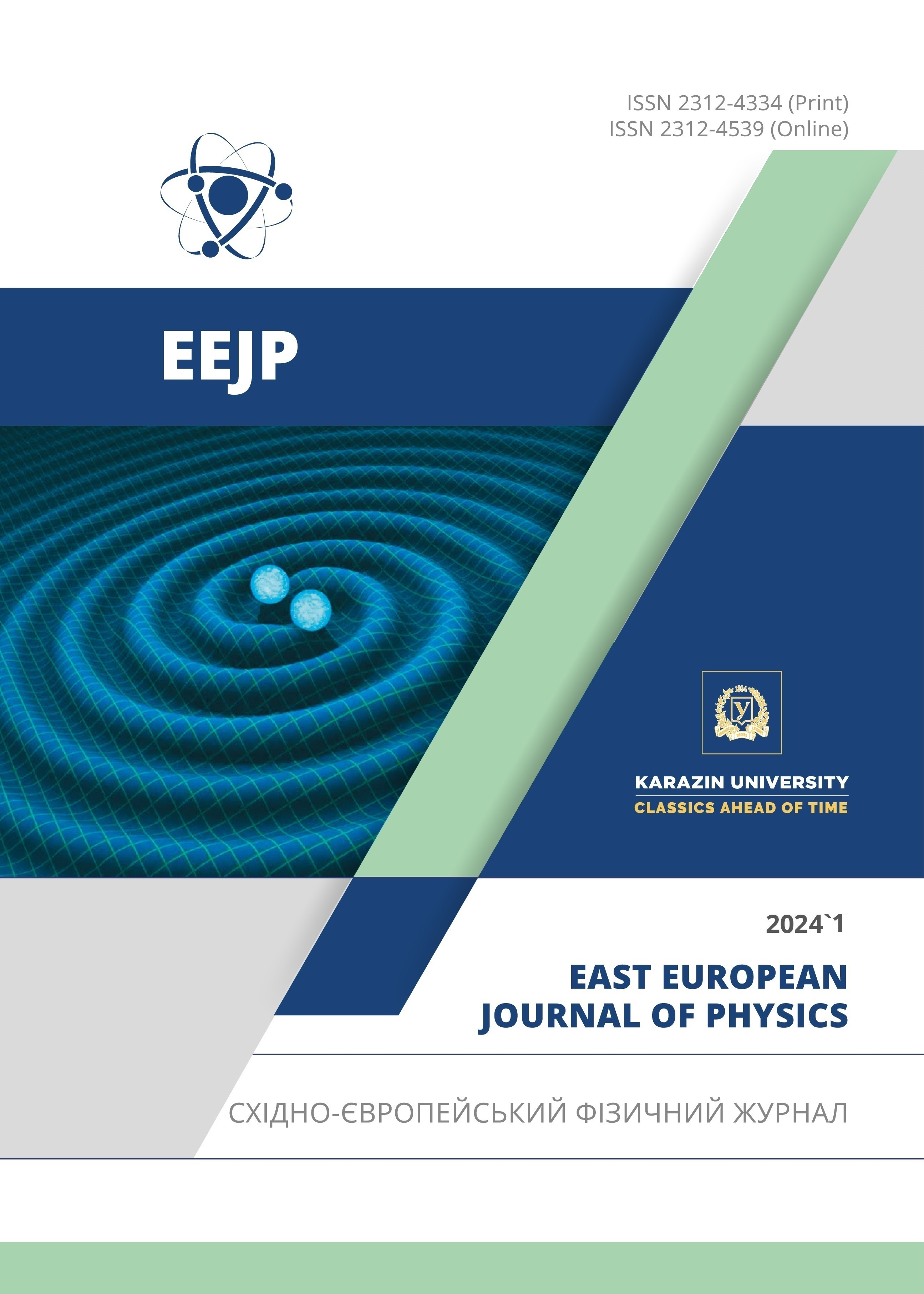Температурна залежність діелектричної релаксації спектрів поглинання у системі хлорбензол – йодобензол
Анотація
У статті наведено результати дослідження температурної залежності діелектричної проникності ε' та показника діелектричних втрат ε" системи хлорбензол-йодбензол в діапазоні довжин хвиль λ = 6,32; 4,01; 3,21; 2,14; 1,18 та 0,75 та у температурному інтервалі -40℃÷+30℃ Визначено статичну діелектричну проникність на частоті 7 МГц. Визначено температурну залежність часу діелектричної релаксації молекул у рідкому стані. Встановлено, що у вказаному діапазоні частот температури дисперсійна область складається з двох частин. Аналіз температурної залежності діелектричної релаксації поляризації в системі хлорбензол-йодбензол показує, що часи релаксації компонентів не залежать від їх ближнього порядку. Також виявлено, що графік швидкості, який показує залежність логарифму часу релаксації від величини, зворотної до температури logτ ~ 1/T, складається з двох частин, а значення статичної діелектричної проникності ε∞ є неаддитивним. Для пояснення цих результатів зроблено припущення, що в цій системі утворюються кластери, як і в чистих компонентах.
Завантаження
Посилання
S.T. Azizov, AJP Phys. 2, 18 (2020). http://physics.gov.az/physart/251_2020_02_20_en.pdf
S.T. Azizov, Phys. New. 5, 118 (2020). http://physics.gov.az/Transactions/2020/journal2020(5).pdf. (in Russian)
S.T. Azizov, O.A. Aliyev, and K.E. Zulfugarzade, APJ Phys. 4, 22 (2017). http://www.physics.gov.az/physart/164_2017_04_22_en.pdf
S.T. Azizov, and O.A. Aliyev, AJP Phys. 3, 14 (2018). http://physics.gov.az/physart/008_2018_03_14_az.pdf. (in Russian)
D. Kumar, S. Nand, and S. Sahoo, J. Solution Chem. 50, 690 (2021). https://doi.org/10.1007/s10953-021-01085-4
T. Bachhar, S. Sit, S. Laskar, and S. Sahoo, Bull. Mater. Sci. 44, 120 (2021). https://doi.org/10.1007/s12034-021-02366-w
F. Kremer, and A. Schonhals, Broadband Dielectric Spectroscopy, 12, 729 (2002). https://link.springer.com/book/10.1007/978-3-642-56120-7
J.P. Poley, Appl. Sci. Res. 4, 337 (1955). https://doi.org/10.1007/BF02920014
S. Murakami, Y. Akutsu, S. Habaue, O. Haba, and H. Higashimura, Nat. Sci. 2, 803 (2010). https://doi.org/10.4236/ns.2010.28101
A.J. Van Eiсk, and J.Ph. Pоleу, J. Appl. Sci. Res. 6, 359 (1957). https://doi.org/10.1007/BF02920392
V.A. Durov, and O.G. Tereshin, J. Phys. Chem. В, 110, 8441 (2006). https://doi.org/10.1021/jp056541y
S.A. Abdel-Latif, and S.E. Mansour, Nat. Sci. 2, 793 (2010). https://doi.org/10.4236/ns.2010.28100
A. Pillay, M. Elkadi, F. Feghali, S.C. Fok, G. Bassioni, and S. Stephen, Nat. Sci. 2, 809 (2010). https://doi.org/10.4236/ns.2010.28102
E.Y. Salaev, E.R. Gasimov, S.T. Azizov, and Ch.O. Qajar, Turk. J. of Phys. 5, 389 (1998). https://journals.tubitak.gov.tr/physics/vol22/iss5/4/
D.M. Fouad, A. Bayoumi, M.A. ElGahami, S.A. Ibrahim, and A.M. Hammam, Nat. Sci. 2, 817 (2010). https://doi.org/10.4236/ns.2010.28103
A.H. Rageh, S.R. El-Shaboury, G.A. Saleh, and F.A. Mohamed, Nat. Sci. 2, 828 (2010). https://doi.org/10.4236/ns.2010.28104
S.R. Kasimova, Meas. Tech. 58, 1372 (2016). https://doi.org/10.1007/s11018-016-0901-9
R.H. Cole, The J. of Chem. Phys. 23, 493 (1955). https://doi.org/10.1063/1.1742017
R. Aipova, S.A. Aitkeldiyeva, A.A. Kurmanbayev, A.K. Sadanov, and O.B. Topalova, Nat. Sci. 2, 841 (2010). https://doi.org/10.4236/ns.2010.28105
C.D. Abeyrathne, M.N. Halgamuge, P.M. Farrell, and E. Skafidas, Phys. Chem. Chem. Phys. 16, 13943 (2014). https://doi.org/10.1039/C4CP00716F
T.M. Mohan, S.S. Sastry, and V.R.K. Murthy, J. of Molec. Struc. 12, 157 (2010). https://doi.org/10.1016/j.molstruc.2010.03.065
K. Sorimachi, Nat. Sci. 2, 846 (2010). https://doi.org/10.4236/ns.2010.28106
C.J.F. Böttcher, and P. Bordewijk, Theory of Electric Polarization, (Elsevier, Amsterdam, 1978).
Авторське право (c) 2024 Самір Азізов

Цю роботу ліцензовано за Міжнародня ліцензія Creative Commons Attribution 4.0.
Автори, які публікуються у цьому журналі, погоджуються з наступними умовами:
- Автори залишають за собою право на авторство своєї роботи та передають журналу право першої публікації цієї роботи на умовах ліцензії Creative Commons Attribution License, котра дозволяє іншим особам вільно розповсюджувати опубліковану роботу з обов'язковим посиланням на авторів оригінальної роботи та першу публікацію роботи у цьому журналі.
- Автори мають право укладати самостійні додаткові угоди щодо неексклюзивного розповсюдження роботи у тому вигляді, в якому вона була опублікована цим журналом (наприклад, розміщувати роботу в електронному сховищі установи або публікувати у складі монографії), за умови збереження посилання на першу публікацію роботи у цьому журналі.
- Політика журналу дозволяє і заохочує розміщення авторами в мережі Інтернет (наприклад, у сховищах установ або на особистих веб-сайтах) рукопису роботи, як до подання цього рукопису до редакції, так і під час його редакційного опрацювання, оскільки це сприяє виникненню продуктивної наукової дискусії та позитивно позначається на оперативності та динаміці цитування опублікованої роботи (див. The Effect of Open Access).








